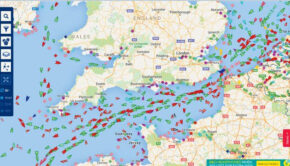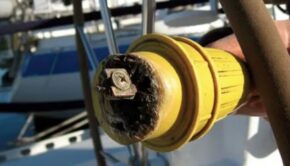The Real Risk of Powerlines
Published on July 13th, 2022
by Drew Frye, Practical Sailor
Seven years ago, in my home cruising grounds of Chesapeake Bay, high voltage electricity arced from a powerline to the mast of a 35-foot sailboat while the mast was still 12 feet from the wire. The people jumped into the brackish water and there were no serious injuries, but the boat burned to the waterline.
Per the National Electrical Safety Code (NESC), if the surface area of a body of water is between 200 and 2,000 acres, the minimum powerline clearance is 34 feet, on water bodies over 2,000 acres, the minimum clearance is 40 feet. On reservoirs over 2,000 acres and in coastal water, the minimum is 52 feet for powerboats only, and 57 feet if sailboats are present.
However, “sailboat waters” can exclude coves, shallows, and channels in marinas registered as power boat facilities.
LAUNCH RAMPS
NESC clearances for electrical lines in areas posted for rigging or launching sailboats also vary depending on surface area of the body of water and must be 5.5 feet greater than the minimums, but this is not always the case.
Lines can also sag in the summer under high air conditioning loads (the wires get warm and stretch). The rating is supposed to allow for this, but exceptions have been known. Lines also sag after installation. More reasons you need a safety factor.
The NESC Code for minimum clearances based on waterbody size are physical distances from the high water level to the wire. But remember, electricity can arc between conductors. The higher the voltage, the farther electricity can arc.
Sailboat masts make great conductors, so just because you won’t physically touch the wire does not make it safe to pass under it. Here are minimums per the Occupational Safety and Hazard Administration (OSHA).
OSHA MINIMUM CLEARANCE DISTANCES*
Up to 50 kV 10 ft.
> 50 to 200 kV 15 ft.
> 200 to 350 kV 20 ft.
> 350 to 500 kV 25 ft.
> 500 to 750 kV 35 ft.
> 750 to 1,000 kV 45 ft.
*Clearances for voltages greater than 1,000 kV are established by engineers on site.
The clearances assume that the line is in compliance with regulations, and that the appropriate notifications were made. Around marinas, ramps, reservoirs, and smaller rivers, don’t bet on this.
Note the authorized clearance on your charts. If not stated, look at a smaller scale chart, call the power company, or just don’t pass under it. Even more than bridge clearance, wire height is notoriously difficult to gauge from deck level, and just because another boat passed under it does not mean it won’t arc to your mast on a different day under different conditions.
Editor’s note: To read comments regarding this report, click here.









 We’ll keep your information safe.
We’ll keep your information safe.